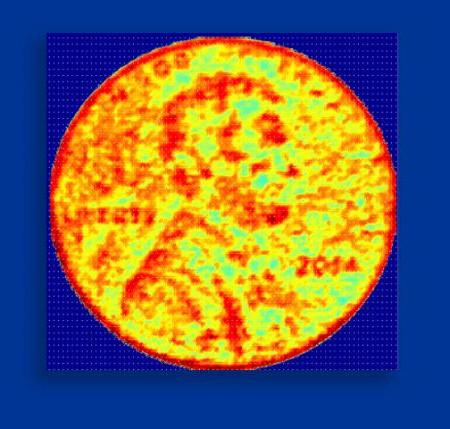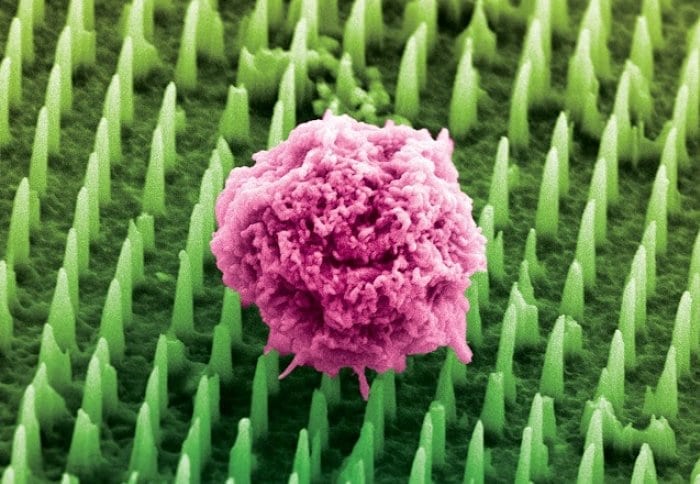
Credit: Ali Hajimiri/Caltech
Imagine you need to have an almost exact copy of an object. Now imagine that you can just pull your smartphone out of your pocket, take a snapshot with its integrated 3-D imager, send it to your 3-D printer, and within minutes you have reproduced a replica accurate to within microns of the original object.
This feat may soon be possible because of a new, tiny high-resolution 3-D imager developed at Caltech.
Any time you want to make an exact copy of an object with a 3-D printer, the first step is to produce a high-resolution scan of the object with a 3-D camera that measures its height, width, and depth. Such 3-D imaging has been around for decades, but the most sensitive systems generally are too large and expensive to be used in consumer applications.
A cheap, compact yet highly accurate new device known as a nanophotonic coherent imager (NCI) promises to change that. Using an inexpensive silicon chip less than a millimeter square in size, the NCI provides the highest depth-measurement accuracy of any such nanophotonic 3-D imaging device.
The work, done in the laboratory of Ali Hajimiri, the Thomas G. Myers Professor of Electrical Engineering in the Division of Engineering and Applied Science, is described in the February 2015 issue of Optics Express.
In a regular camera, each pixel represents the intensity of the light received from a specific point in the image, which could be near or far from the camera—meaning that the pixels provide no information about the relative distance of the object from the camera. In contrast, each pixel in an image created by the Caltech team’s NCI provides both the distance and intensity information. “Each pixel on the chip is an independent interferometer—an instrument that uses the interference of light waves to make precise measurements—which detects the phase and frequency of the signal in addition to the intensity,” says Hajimiri.
The new chip utilizes an established detection and ranging technology called LIDAR, in which a target object is illuminated with scanning laser beams. The light that reflects off of the object is then analyzed based on the wavelength of the laser light used, and the LIDAR can gather information about the object’s size and its distance from the laser to create an image of its surroundings. “By having an array of tiny LIDARs on our coherent imager, we can simultaneously image different parts of an object or a scene without the need for any mechanical movements within the imager,” Hajimiri says.
Read more: New Camera Chip Provides Superfine 3-D Resolution
The Latest on: Nanophotonic coherent imager
[google_news title=”” keyword=”Nanophotonic coherent imager” num_posts=”10″ blurb_length=”0″ show_thumb=”left”]
via Google News
The Latest on: Nanophotonic coherent imager
- Space pictures! See our space image of the dayon May 9, 2024 at 11:46 am
It's an image constructed with data from the now-retired Spitzer space telescope, and indicates streams of dust around the central region of Andromeda are getting swept within. Inside the central ...
- Camera Reviewson May 6, 2024 at 6:39 am
Dive into our detailed measurements of image quality, shutter lag, cycle time, and battery life. For a listing of the best cameras, see the Dave's Picks pages. Compare standardized photos from ...
- Radiology & Imaging newson April 30, 2024 at 5:00 pm
A novel investigational PET imaging agent can rapidly and accurately visualize lesions in clear cell renal cell cancer (ccRCC) patients according to new research published in the May issue of The ...
- How to tell a story in an imageon April 28, 2024 at 8:00 am
Elements are assembled almost randomly, and the overall image lacks the meaning, coherence and intention that can only come from a human artist. A way artists can fight back against generative AI ...
- WhatsApp is testing a new image attachment pageon April 18, 2024 at 5:00 pm
Now, this popular instant messaging app could get rid of tabs in the image attachment UI. While the system is intuitive and familiar, reputable tipster and app researcher AssembleDebug on X ...
- Stability AI opens up Stable Diffusion 3 API to developerson April 17, 2024 at 3:38 pm
This architecture allows the model to effectively combine textual input with its visual understanding, resulting in more realistic and coherent image generation. Powerful text-to-image generation ...
- Cardiovascular Magnetic Resonance Imagingon April 16, 2024 at 5:01 pm
New advances in the field of MRI allow for the performance of a wide variety of cardiovascular imaging protocols. Nurses with familiarity with the MRI environment and the protocols used to assess ...
- How to spot an AI generated image: 8 tips you should knowon April 14, 2024 at 5:00 pm
AI image generators are the result of two new technologies: large language models and diffusion models. You may already be familiar with large language models like GPT-4 that can understand ...
- Medical Imaging Newson April 14, 2024 at 5:00 pm
May 7, 2024 — Researchers have harnessed the technology behind foundation models, which power tools like ChatGPT, to discover new cancer imaging biomarkers that could transform how patterns are ...
- How to tell if an image is AI-generatedon April 8, 2024 at 1:45 am
Image generators are not text generators, and creating pictures with elements that look like text is a very different job to creating actual readable text. Misspelled words, letters that blur ...
via Bing News









